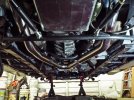RAU03MACH
Legend
I always put a couple of good grounds so I have no issues
Most Ford starters max out at 350A, but it depends on lots of things like compression ratio, reciprocating weight, current temperature, maybe even the oil weight but now we're just splitting hairs. FWIW, these cars from the factory are not fused on the starter wire. I'm not sure about these days, but I'd go so far as to say that most cars from this era just have a hot, unfused lead going to the starter motor. What I did was overkill, TBH.thanks for all the info guys, and good topic to discuss because I’m still undecided about what size breaker to install. If I remember correctly shouldn’t you set your safeguard(fuse or breaker) 10-20% above your highest amp drawing?
Not sure what the starters normally draw.

The only issue I had with inside the car, was fitting that large cable under the carpet. I have pictures in my build thread somewhere around 2016, but mine goes in the rocker in the passenger wheel well and into the car under the rear seat. I think @white95 has his that way and may have pictures.Do you all see any issue with running the positive wire through the inside of the car?
The only issue I had with inside the car, was fitting that large cable under the carpet. I have pictures in my build thread somewhere around 2016, but mine goes in the rocker in the passenger wheel well and into the car under the rear seat. I think @white95 has his that way and may have pictures.

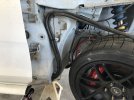
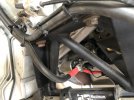
I do carpet burnsDo you all see any issue with running the positive wire through the inside of the car?
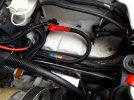
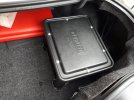
Yes, you do not need a monster cable running up and down the length of the car (1/0 is already quite beefy, trust me). Anything more is just hypothetical added insurance. There's no way you're going to "melt" a 1/0 cable with common loads these cars experience. Now... if you're quading out with ten 15" subs and five amps, that's a whole nother story and the car's entire electrical system will change anyways.This chart is great for sizing your wire according the the length and amperage you will need correct?
With this, there's again more than one way to slice the pie. Realistically for a street car that doesn't experience routine abuse, no fuse link is necessary. If the wire is sufficiently separated from impact zones, heat sources, and moving parts, just run it like factory and save yourself time/money/headache. If any of those things start to become concerns, then start thinking about different ways to overcome them. Example, if trunk cable (heavy gauge direct to battery) lies in an area that is potentially shorted even with a light impact with another car or something stationary, then fuse it close to the battery as possible.The goal for my car is just to be a well performing and clean street car. I don’t have plans to race it in any events with rules and stuff.
So now what is you all’s experience with the circuit breaker or fuse size? What sizes work well from you all experience. I know everyone has a different opinion on this topic but I just want to know what has worked for you all, TIA.
Man, I run a 4/0 cable power and ground from my trunk to the engine. It turned my 13:1 compression 2 valve and now turns my 12.5:1 compression coyote. The wire is inside the rocker panel of the car and over no sharp edges. I have power and ground from the battery to the starter and block respectively. It’s been this way since 2016 and I’ve got A LOT of miles on it.
I have no breaker or fuse.
If your car doesn’t start, don’t hold the key and load the starter excessively. You know if there is a problem.
We can “what if” this topic to death, but the truth is, there are many problems that can arise by moving the battery, and there is no 1 correct way to do it.
I tried to keep my power distribution close to the stock setup. I’ve got power straight to the starter, and a power wire from the starter to the fuse box. Then power from the fuse box to the alternator. I’ve got ground from battery to motor mount bolt, then ground from a transmission bolt to chassis. Everything works great.
Only thing about it is that it has very little impact protection, if any at all, being inside the rocker panel. I went for getting the cable as far inboard as possible, but alas it's an SN95 so there's only so much leeway.That is how ive been doing it for 30 years or so. Never had any issues.
Only thing about it is that it has very little impact protection, if any at all, being inside the rocker panel. I went for getting the cable as far inboard as possible, but alas it's an SN95 so there's only so much leeway.
